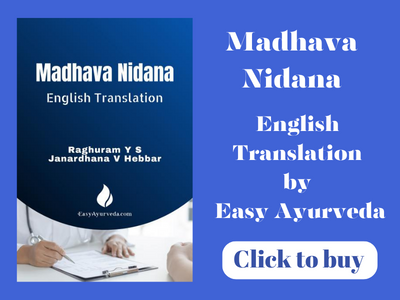Madhava Nidana Chapter 35 Udara Nidanam
This article explains Madava nidana 35th chapter “Udara Nidanam”. Causes, pathology and symptoms of Udara are explained in this chapter.
Read – Acharya Madhavakara: His Work ‘Madhava Nidana’, Legacy, Amazing Facts
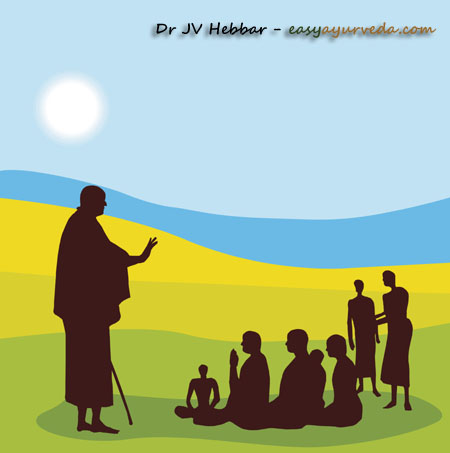
Table of Contents
Udara Roga Nidana
Etiological Factors for Udara Roga
All diseases in the body, mainly the udara rogas (enlargement of abdomen) are caused by mandāgni (poor digestive fire), indigestion of food, and excessive consumption of dirty or spoiled (contaminated) foods and accumulation of waste products in the body (excreta and other metabolic wastes). (1)
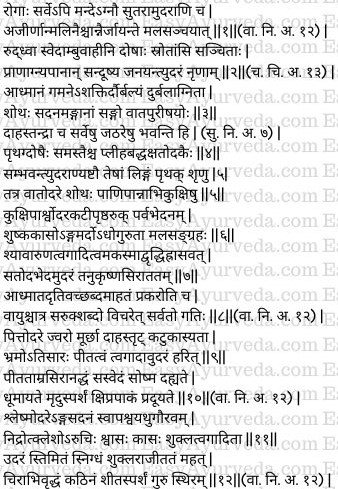
Udara Roga Samprapti
Pathogenesis of enlargement of abdomen
The doshas undergoing increase and accumulation obstruct the channels of sweat and other body fluids, vitiate prāna, apāna and agni (pitta) and produce Udararoga (enlargement of abdomen). (2)
Read – Charaka Udara Roga Chikitsa – 13th Chapter
Udara Samanya Lakshana
General symptoms
- distension of the abdomen,
- inability to walk,
- weakness,
- weakness of digestive fire (capacity)
- swelling / edema
- looseness / debility in the body parts (extremities)
- obstruction to the movement (expulsion) of flatus and faeces
- burning sensation
- stupor (3-4)
Udara Samkhya
Types of Udara Roga – Udara is of eight kinds.
- one from each doșha – vataja udara (vatodara), pittaja udara (pittodara) and kaphaja udara (shleshmodara / kaphodara)
- one from the combination of all three vitiated doshas – sannipatodara
- pleehodara,
- baddhodara,
- kshatodara and
- udakodara / jalodara
The symptoms of each of these 8 types of udara will be described separately further on. (4)
Read – Udarda Prashamana Gana – Anti Allergic Herb Group Of Charaka
Vatodara Symptoms
The symptoms of Vatodara are –
swelling (oedema) of the hands, feet, umbilicus and lower abdomen;
pain in the cavity of the abdomen, flanks, abdomen, waist (pelvis), and back and splitting pain in the joints, mainly small joints of the hands and feet (fingers and toes);
Dry cough, body aches, feeling of heaviness of the lower parts of the body, accumulation of wastes products (excreta) in the body,
dark brown (bluish) or reddish-brownish (golden yellow) discolouration of skin, etc. (nails, eyes, face, teeth etc),
sudden increase or decrease of size of the abdomen without any apparent reason,
pricking, throbbing and other types of pain in the abdomen,
appearance of thin, black network of veins on the abdomen,
highly resonant sound elicited on percussion (sound resembling that coming when you tap on a bag / sac filled with air) and the vayu (gases) move all round inside the abdomen (intestines) producing gurgling noises and pain. (5-8)
Pittodara Symptoms
Symptoms of Pittodara are – fever, loss of consciousness (fainting),
burning sensation, thirst, manifestation of bitter taste in the mouth,
giddiness, diarrhoea, yellowish discolouration of skin (nails, eyes, teeth, face) etc.,
and greenish colour of the abdomen, network of veins of yellow or coppery colour spread out over the abdomen,
sweating, feeling of excessive heat and burning sensation, sensation of hot smoke or fumes from the surface of the abdomen,
abdomen is soft to touch and the condition (pittaja udara) undergoes quick suppuration (quickly progresses towards ascites) and there will be severe pain in the abdomen. (9-10)
Kaphodara Symptoms
The symptoms of Kaphodara are – debility, loss of activity, oedema and heaviness of the body parts,
excessive sleep, nausea, loss of taste, dyspnoea (difficulty in breathing),
cough, whitish discolouration of skin (nails, eyes, teeth, face) etc.
The abdomen is tense (loss of movements), unctuous, having white striae (covered by long white marks / streak), large in size, increasing slowly, hard, cold to touch, heavy and without movement. (11-12)
Read – Ascites: Ayurvedic Treatment, Remedies, Medicines
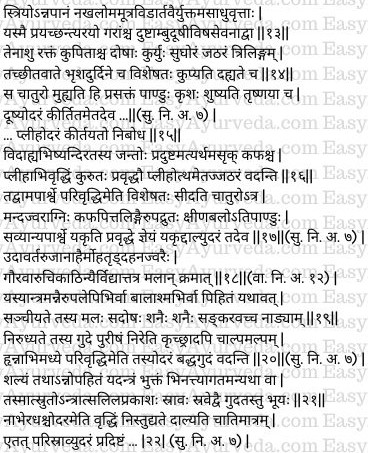
Sannipatodara Symptoms
Causative factors of Sannipatodara are –
- Ingestion of harmful foods containing (mixed with) nails, body hairs, urine, faeces and menstrual blood etc by women of bad or unappreciable nature (wicked women) or by wicked men or enemies, or
- consumptions of foods mixed with (artificial) poisons served by enemies,
- drinking polluted water
- consumption of slow poisons etc
Pathogenesis – Due to the consumption of the above said etiological factors, the blood along with the three doshas will get aggravated in quick time and cause tridoshaja udara roga. In this condition the symptoms of all the three doshas will be present together.
Symptoms – This symptom of this condition exacerbates in cold breeze (on days of cold breeze) and overcast conditions (when the sky is enveloped by clouds), and there is severe burning sensation. The person faints frequently, is pale, emaciated, and his mouth gets dried due to severe thirst. This condition is also called as Dusyodara also. (13-14)
Read – Excessive Thirst – Ayurvedic Understanding And Treatment
Plihodara Symptoms
Understand the symptoms of Pleehodara (which has been explained) further
In persons who indulge in foods which produce burning sensation during digestion and those which block the tissue pores by greasy material, the rakta (blood) and kapha undergo severe aggravation.
They in turn cause enlargement of the spleen and produce plihodara (splenomegaly). In this condition the abdomen is enlarged more towards the left side. The patient is very much debilitated, will have mild fever, poor digestion, symptoms of increased kapha and pitta, loss of strength and severe form of anaemia. (15-16)
Read – Splenomegaly – Ayurveda Concept, Symptoms, Causes, Remedies
Yakrutodaram / Yakruddalyudaram
If there is such an enlargement on the right side of the abdomen (just like in plihodara) involving the liver, the disease shall be named as Yakrtodara (hepatomegaly). (17)
Dosha symptoms in both Plihodara and Yakrtodara
In both these conditions i.e., plihodara and yakrtodara, the dosha involvement should be understood on seeing the associated dosha symptoms –
- in association of vata, the symptoms of vata are seen, they are – upward movement of vata, pain in the abdomen and flatulence (distension of abdomen)
- in association of pitta, the symptoms of pitta are seen, they are – delusion (loss of consciousness), thirst, burning sensation and fever
- in association of kapha, the symptoms of kapha are seen, they are – heaviness in the abdomen, loss of taste in food, and hardness of the abdomen (18)
Read – Hepatomegaly – Causes, Symptoms, Treatment, Prognosis
Baddha Gudodara
Due to the obstruction of the intestines by food materials which are sticky in nature, hairs, stones, etc. the wastes (faeces) along with the three doshas gradually accumulates inside the intestines just like a mixture of dirt (just like the dirt gradually accumulates in a tube or pipe and prevents free flow of water within).
The waste materials thus accumulated in the anus (intestines) get eliminated in small quantities (in the form of small pellets) with great difficulty. In this condition the abdomen is enlarged between the chest and umbilicus. This condition is called Baddha gudodara (intestinal obstruction). (19-20)
Read – Constipation Causes, Ayurvedic Treatment, Home Remedies
Parisravyudara Symptoms
When the foreign bodies (objects) are ingested along with the food or otherwise damages and tears the walls of the intestine or if there is perforation of the wall of the intestine due to any other cause, it will lead to exudation of watery material in large quantities. This watery fluid will accumulate in the abdominal cavity and produce enlargement of the abdomen. Later this fluid will get discharged through the anal route. In this condition the enlargement of the abdomen takes place below the umbilicus. The person will experience pricking or crushing (tearing, bursting) pain in the abdomen. This type of udara is called Parisraaviudara (intestinal perforation and peritonitis). (21-22)
Read – Pelvic Inflammatory Disease: Causes, Symptoms, Pathogenesis, Diagnosis
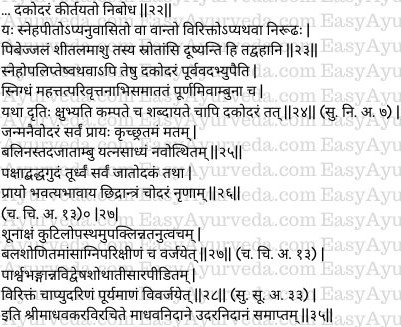
Jalodara symptoms
Understand the type of udara called as Dakodara now –
When a patient drinks cold water immediately after he has undergone (administered with) therapies like oleation – oral consumption of medicated lipids (oil or ghee) as part of therapy, unctuous (oil or ghee) enema, emesis, purgation or decoction enema, it would cause contamination of the channels of water / fluids. Also when the interior of the water / fluid conveying channels get coated and obstructed by unctuous material (oily material), the fluid gets accumulated in the abdominal cavity as explained in Chidrodara and causes dakodara (ascites).
The abdomen is unctuous (oily appearance) and is greatly enlarged with the umbilicus protruding out. The abdomen trembles (shakes), produces movements and sounds just like a leather bag filled with water. This condition is called Dakodara (enlargement of the abdomen due to the accumulation of the fluid, ascites). (23-24)
Read – How To Make Prognosis Of Disease According To Ayurveda?
Symptoms of incurability of Udara
Generally, all kinds of udara rogas are difficult to cure right from the time of their onset. This condition can only be cured with great effort in persons who are strong (strong constitution), before the formation of fluid (before fluid accumulates in the abdominal cavity) and when it is of recent onset. Baddha Gudodara will become incurable after the lapse of 15 days (if it cannot be cured within a fortnight it cannot be cured at all). All other types of abdominal enlargements which have progressed to the stage of ascites (accumulation of fluid in the abdominal cavity) are incurable. Parisravi Udara – wherein there is perforation of intestines are going to be fatal and hence incurable. (25-26)
Other symptoms of incurability of udara roga
Patients of udara who have developed oedema of the eyes, abnormal curvature of the penis, wet and thin skin, and loss of strength, blood, muscles and digestive capacity are to be refused treatment.
Similarly, when there is compression of the ribs (compression or pain in the flanks), aversion to food, oedema, diarrhoea and fluid accumulating quickly in spite of administering repeated purgation (therapy) are to be rejected. (27-28)
Thus ends the chapter on Udara Nidanam in Madhava Nidana text written by Acharya Madhavakara.




